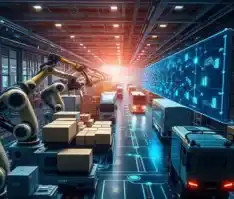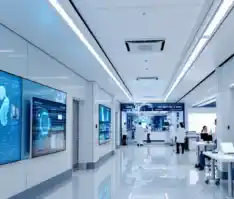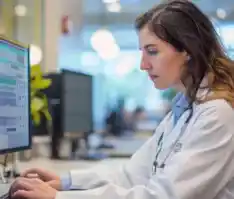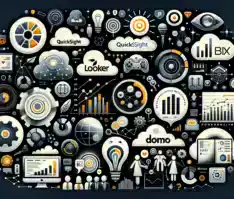Table of Contents
In an era where Industrial safety is paramount, AI-Powered Safety & Monitoring Solutions are revolutionizing how industrial safety in high-risk industries can play an important role to protect their workforce from hazards and enhance operational efficiency. The evolution of industrial safety has seen tremendous change. What originally began as a time-consuming, manual process with a high learning curve has evolved into a more accurate and effective system, facilitated by artificial intelligence (AI)-Powered Safety & Monitoring solutions.
During the early 1800s, initial indsutrial safety regulations were implemented to promote floor cleanliness and proper ventilation. However, the first meaningful legislation regarding workplace industrial safety was enacted in Massachusetts in 1877, requiring fire exits, proper ventilation, and protective guards on dangerous machinery. As we move forward into the contemporary world, it becomes clear that, while Industrial safety requirements have become much more extensive and protective of workers, manual safety checks still make businesses vulnerable to costly mistakes and accidents.
In spite of these improvements, a recent AFL-CIO survey reported that the rate of workplace fatalities in 2022 remained a worrying 3.4 per 100,000 workers. Many companies hope to leverage AI to make manual monitoring more effective, ultimately working to lower this number and make the workplace safer for workers in a variety of job categories.
In high-risk industries like mining, construction, and oil and gas, hazardous working conditions pose life-threatening risks daily. The Bureau of Labor Statistics reports that these sectors lead in workplace fatalities, with construction alone accounting for 21% of all workplace deaths in 2021. This stark reality encapsulates a pressing need for innovation in industrial safety management.
Industrial Safety: The Need for Innovation in High-Risk Industries
Indsutrial Safety: Overview of High-Risk Industries
Imagine stepping onto a bustling construction site, surrounded by the deafening roar of machinery, or descending into a deep mine, enveloped in darkness. This is the life of countless workers. High-risk industries such as mining, construction, oil and gas, agriculture, and transportation form the backbone of the global economy. They present unique challenges—heavy machinery, hazardous materials, and extreme environments create a volatile cocktail of risk, demanding more than the traditional measures of safety. This is where AI-Powered Safety & Monitoring Solutions come into play, revolutionizing safety protocols and enabling organizations to proactively identify and mitigate risks, ensuring a safer working environment for all.
Industrial Safety: Challenges Faced in Safety Management
Despite stringent industrial safety protocols, the truth remains: accidents still happen. The failure to adhere to industrial safety regulations, unpredictability in human behavior, and limitations of current technology often conspire against a safe working environment. Even robust systems sometimes fall short, emphasizing the need for a cultural shift where industrial safety is not just a guideline but a core value across all operations.
What if we could leverage artificial intelligence (AI) to revolutionize industrial safety management? AI-Powered Industrial Safety & Monitoring Solutions —such as machine learning algorithms, predictive analytics, and computer vision—are transforming how organizations approach industrial safety. Imagine systems that autonomously track risk factors in real-time, alerting Health and Safety managers to potential hazards before they escalate. This proactive approach shifts industrial safety from a reactive measure to a preventative culture, fundamentally changing the landscape of industrial safety across high-risk industries.
Industrial Safety: Key AI Technologies Transforming High-Risk Industries
As we delve into AI-Powered Industrial Safety & Monitoring Solutions, we will explore how these innovations not only protect lives but also foster a robust industrial safety culture in high-risk industries, making industrial safety more than just a policy — but a promise.
Some other than other key technologies stand out in the world of AI-Powered Industrial Safety & Monitoring Solutions. Let’s explore innovations in these game-changing technologies that are shaping the future of workplace safety.
Machine Learning Algorithms
Machine learning is revolutionizing Industrial Safety compliance and hazard identification. For instance, many workers often overlook PPE requirements because the equipment can be cumbersome or they may feel invulnerable, which leads to noncompliance. But what if AI-Powered Industrial Safety & Monitoring Solutions could change that? Imagine a computer vision system with AI-enabled cameras that continuously monitor designated zones for PPE compliance. With instant alerts, Industrial safety becomes a priority rather than an afterthought. This transformation not only ensures adherence to industrial safety protocols but also fosters a culture where every worker is empowered to prioritize their well-being, fundamentally enhancing industrial safety across high-risk industries.
Applications Computer Vision
Think about the hazardous debris or spills that litter job sites—poor visibility can lead to serious accidents. Here’s where AI-Powered Industrial Safety & Monitoring Solutions kill two birds with one stone. Advanced computer vision can identify and log hazardous objects in real time, linking trends to enterprise data to foster safer practices. Imagine being able to adjust your safety protocols based on real-time data, enhancing both industrial safety and operational performance.
With this technology, organizations can proactively address issues before they escalate, ensuring a safer work environment for everyone. By leveraging AI’s capabilities, companies not only improve compliance with industrial safety regulations but also create a culture that prioritizes accident prevention.
Think about the hazardous debris or spills that litter job sites—poor visibility can lead to serious accidents. Here’s where AI kills two birds with one stone. Advanced computer vision can identify and log hazardous objects in real time, linking trends to enterprise data to foster safer practices. Imagine being able to adjust your industrial safety protocols based on real-time data, enhancing both safety and operational performance.
This is the future of industrial safety management, where informed decisions are made in the moment, leading to significant improvements in overall workplace safety and efficiency.
Predictive Analytics
The industrial safety of tomorrow will be about predicting risks before they strike. Heavy machinery operators need to remain fully alert, but fatigue can catch up with the best of us. Here’s where AI-Powered Safety & Monitoring Solutions come to the rescue: a facial expression analysis system can detect fatigue or drowsiness, alerting the worker to take a break before disaster strikes. In this sense, we can think of it as a digital safety assistant that is always on watch!
And what about fall prevention? There are AI-driven apps that provide timely alerts to detect falls before it’s too late, potentially saving lives and preventing serious injuries.
Drones and Autonomous Vehicles
Drones and self-driving cars: there is no reason to send the workers inside a hazardous location as drones can complete the job without exposing anyone to harm.
Conversational AI and Voice Reporting
Industrial Safety procedures? No worries! Chatty AI-powered chatbots trained in industrial safety procedures can give rapid answers using natural language processing. On the flip side, envision incident reporting at ease. Voice-activated AI transcribes your spoken reports to extract all necessary data efficiently.
Augmented Reality (AR) and Virtual Reality (VR)
Want to enhance repairs and training? AR can guide employees through equipment maintenance, offering real-time instructions for repairs. Meanwhile, VR excels in industrial safety training, simulating hazardous scenarios where employees can practice responses in a risk-free environment.
Wearables and Employee Health Monitoring Systems
Imagine slipping on a wristband that does more than track steps. AI-Powered Industrial Safety & Monitoring Solutions integrated into wearables provide real-time data on fatigue, stress, and other health indicators that could affect an employee’s ability to perform tasks safely. Picture a scenario where your team receives an alert as soon as their stress levels rise, enabling them to take a well-deserved break before exhaustion leads to accidents. Moreover, wearables equipped with location tracking capabilities can ensure rapid response times during emergencies. This innovative approach not only fosters a safer work environment but also demonstrates a forward-thinking commitment to employee well-being, transforming how organizations prioritize the health and industrial safety of their workforce.
Cobots: The Future of Collaborative Work
Now, let’s talk about cobots—collaborative robots that are transforming how we approach high-risk tasks. AI-Powered Industrial Safety & Monitoring Solutions , embodied in these machines, enable them to work alongside humans, taking on dangerous duties while allowing you to concentrate on strategic planning and cognitive tasks. By minimizing human exposure to hazardous situations, cobots significantly enhance workplace safety and reduce the likelihood of error-induced accidents.
These robots are engineered for precision and efficiency, effectively taking over potentially perilous roles. In fact, some utility companies are already deploying autonomous robots for inspection rounds in unmanned facilities, operating completely without human intervention. This shift not only safeguards employees but also optimizes human talent for more valuable, strategic work, fundamentally changing the landscape of industrial safety and productivity in high-risk industries.
Benefits of AI in Industrial Safety
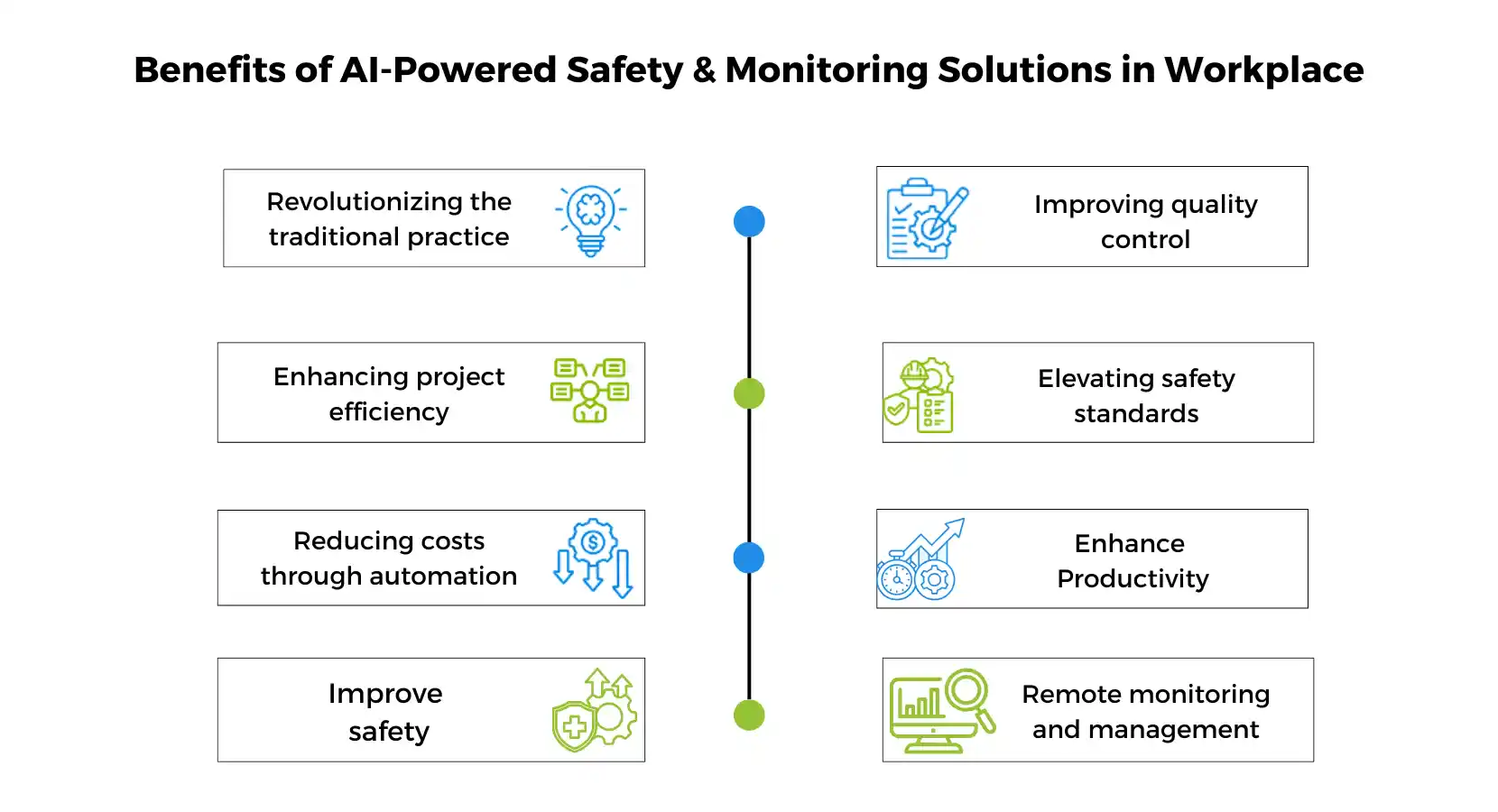
Improved Risk Assessment and Prevention
The first benefit of AI in health and safety is that it analyzes risks and prevents potential hazards before they occur. Companies can use predictive analytics to better implement preventive measures, thus reducing accidents and enhancing overall workplace safety. This proactive approach not only safeguards workers but also reduces the potential downtime and injury-related expenses in the workplace. McKinsey reports that predictive maintenance has been known to reduce the rate of equipment failure by up to 30%, which evidently proves the impact AI can make on both operational reliability and safety.
Real-time monitoring and response
AI technologies provide real-time monitoring and immediate responses to health and safety issues. AI-Powered Safety & Monitoring Solutions leverage sensors and cameras for continuous surveillance of work environments, swiftly identifying any safety breaches or deviations from standard procedures. In high-risk sectors such as construction and manufacturing, AI can promptly alert supervisors to potential dangers, enabling timely interventions to prevent severe incidents. This capability not only reduces the likelihood of serious accidents but also ensures continuous safety compliance in the workplace. By embedding these technologies into daily operations, organizations can significantly enhance their safety protocols and protect their workforce more effectively.
Improved Training with Virtual Reality
AI-based training programs have transformed the delivery of safety education across various industries. AI-Powered Safety & Monitoring Solutions enable AI-driven simulations and virtual reality (VR) environments that provide highly realistic training scenarios, allowing employees to practice their skills in a safe setting with minimal risk. This technology significantly enhances learning retention and equips workers to handle various situations they may encounter on the job.
According to McKinsey, organizations utilizing augmented and virtual reality in training can boost efficiency by up to 70% , making these AI-Powered Safety & Monitoring Solutions essential for workforce readiness. By embracing AI in training programs, companies can foster a culture of safety and ensure that their teams are prepared for any challenge.
With AI-Powered Safety & Monitoring Solutions in training, businesses are not only enhancing their safety protocols but also facilitating easier adaptation to changing workplace environments. As industries evolve, these training tools will play a pivotal role in ensuring employees are always at the forefront of safety practices. By investing in AI-Powered Industrial Safety & Monitoring Solutions , organizations demonstrate a commitment to safeguarding their workforce and optimizing operational efficiency.
Hazard Detection Improved
AI can identify patterns that may be very subtle in system data, something that may go unnoticed by human observation. This means it will identify hazards like equipment failure or unsafe working conditions, thus preventing accidents by taking timely interventions.
Improved Efficiency and Cost Savings
Automated safety checks and monitoring significantly decrease manual workloads, ensuring faster and more accurate responses to safety issues. AI-Powered Safety & Monitoring Solutions streamline safety management, reducing the time taken to prevent incidents, which in turn lowers costs associated with workplace injuries, lawsuits, and regulatory penalties. Studies suggest that organizations employing AI for safety management can cut operational costs by up to 20% thanks to increased efficiency and reduced incident rates. By leveraging these advanced technologies, businesses not only enhance their safety protocols but also achieve substantial financial savings, making AI an indispensable asset in the quest for a safer workplace.
Difficulties in the Use of AI
However, the benefits are substantial, yet the challenges are numerous when implementing AI-Powered Safety & Monitoring Solutions:
- Data Security and Privacy: AI-Powered Safety & Monitoring Solutions deal with sensitive data in large quantities, making it susceptible to hacks and invasion of privacy.
- High Startup Costs: The implementation of AI-Powered Safety & Monitoring Solutions is expensive. It involves significant investments in hardware, software, and training.
- Resistance to Change: Employees and executives may hesitate to adopt AI-Powered Safety & Monitoring Solutions due to fears around job loss or a lack of understanding regarding the benefits AI can provide.
- Compliance: Ensuring AI-Powered Safety & Monitoring Solutions are compliant with health and safety regulations can be reasonably complex, especially when industry standards differ across sectors.
- Data Security and Privacy: The sensitive nature of the data involved in AI-Powered Safety & Monitoring Solutions means that securing this information against potential breaches is crucial for maintaining trust. These challenges must be navigated carefully to unlock the full potential of AI-Powered Safety & Monitoring Solutions in creating safer workplaces.
Conclusion
For the past two decades, it has been well established that a safer workplace is achieved through a combination of effective engineering controls, rigorous training programs, and adequate oversight. Yet, as we stand at the threshold of an unprecedented technological renaissance, it’s evident that AI is the new frontier on this journey—a game changer. We are not merely adding a tool, but rewriting the narrative of risk management.
Imagine a world in which AI works as an unblinking eye, spotting hazards before they turn into incidents and seamlessly blending into risk transfer and claims handling. This is no dream; it is reality in the making. McKinsey reminds us that, by embracing AI in safety processes, organizations can increase their safety outcomes by 25-30% —evidence of how innovation can change things.
But let’s be honest: no progress is without hurdles. New technologies are widely met with skepticism. Data quality, costs, and cultural resistance have to be well negotiated. It’s about changing mindsets rather than just about tools.
With growing capability and sophistication, AI will prove to be the technology that can reshape occupational health and safety practices and unlock new levels of security in our workplaces. The key? To embrace technology while valuing human insight. It’s that synergy that will propel us forward.
By integrating AI-Powered Safety & Monitoring Solutions , we can create environments where workers feel secure and valued, fostering a culture that prioritizes well-being. HyScaler’s journey takes you into a world where safety becomes not just policy but culture. Let’s break the status quo together. Contact us today!
